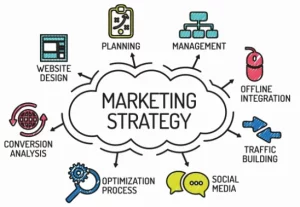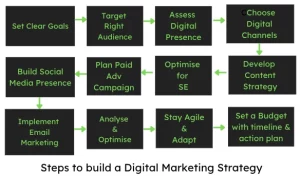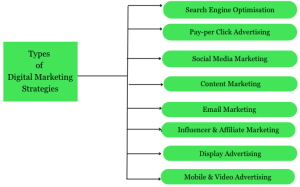What is Digital Marketing Strategy?
A digital marketing strategy is a comprehensive plan and roadmap outlining how a business will utilise digital channels, tactics, and tools to achieve its marketing goals.
It strategically uses various online marketing techniques to reach and engage with the target audience, build brand awareness, drive website traffic, generate leads, and ultimately increase conversions and revenue.
Let us read more about digital marketing strategy and how it helps?
What is SEO in Digital Marketing Strategy?
SEO stands for Search Engine Optimization, a critical component of a digital marketing strategy. It involves optimising a website and its content to improve its visibility and organic (non-paid) rankings in search engine results pages (SERPs).
The aim of SEO is to make a website more attractive so it ranks higher for relevant keywords and phrases that users search for. When a website ranks higher in search results, it increases its visibility and the likelihood of attracting organic traffic.
 In a digital marketing strategy, by optimising various aspects of a website, such as its content, meta tags, headings, URLs, and site structure, SEO aims to make it more relevant and authoritative in the eyes of search engines.
In a digital marketing strategy, by optimising various aspects of a website, such as its content, meta tags, headings, URLs, and site structure, SEO aims to make it more relevant and authoritative in the eyes of search engines.
Read: What is Strategy Consulting?
Importance of SEO Digital Marketing Strategy
Digital marketing strategy is crucial for businesses to effectively utilise digital channels and achieve their marketing objectives. You can read the pointers below to find why having a well-defined digital marketing strategy is of utmost importance:
A strategy gives a clear direction:
SEO digital marketing strategy provides a clear roadmap for achieving marketing goals and objectives. It outlines the target audience, identifies the most relevant digital channels, and sets specific, measurable, achievable, relevant, and time-bound (SMART) objectives. A defined strategy ensures that marketing efforts are focused and aligned with overall business objectives.
You can maximise productivity from resources:
A digital marketing strategy helps optimise the allocation of resources, including budget, time, and personnel. It allows businesses to prioritise and invest in the most effective digital channels and tactics based on their target audience, industry, and available resources. By focusing resources where they are most likely to generate results, businesses can maximise their return on investment (ROI).
Strategy pushes in consistent branding:
Digital marketing strategy ensures consistent branding across various digital touchpoints. It defines the brand voice, messaging, visual elements, and guidelines for content creation. This consistency helps build brand recognition, credibility, and trust among the target audience, regardless of the digital channel they engage with. A strong and consistent brand image enhances customer loyalty and encourages repeat business.
You can have a targeted audience engagement:
A well-crafted digital marketing strategy enables businesses to engage with their target audience more effectively.
By understanding the audience’s needs, preferences, and online behaviour, businesses can create relevant and personalised content, offers, and experiences. This targeted approach increases the likelihood of engagement, conversions, and long-term customer relationships.
Digital Marketing Strategy offers Data-Driven Decision-Making:
A digital marketing strategy emphasises the importance of data and analytics in decision-making. It establishes key performance indicators (KPIs) and measurement frameworks to track and analyse campaign performance. By regularly monitoring and analysing data, businesses can gain valuable insights into what works and what doesn’t. This data-driven approach enables informed adjustments and optimization of digital marketing initiatives.
Your brand can adapt and become agile:
Digital marketing strategies promote adaptability and agility in the face of changing market dynamics. So if you have a strategy in place, you will not absorb the shocker and quickly adapt to the change in the market.
Strategies should include provisions for testing, experimentation, and ongoing optimization. With the ability to quickly respond to market shifts and consumer trends, businesses can stay ahead of the competition and capitalise on emerging opportunities.
Integration and Synergy:
A digital marketing strategy encourages for you integration and synergy across digital channels and marketing efforts. It ensures that the various digital marketing components work harmoniously towards a common goal, reinforcing each other’s impact. This integration enhances the overall effectiveness and efficiency of digital marketing initiatives.
Evaluation and Improvement:
Digital marketing strategies make continuous assessment and improvement fast tracked for you. By regularly reviewing and analysing performance metrics, businesses can identify its areas of strength, weakness, and opportunities for improvement.
This iterative approach enables businesses to refine their strategies, tactics, and messaging, ensuring long-term success in the digital landscape.
Brand Example of Digital Marketing Strategy
Let us read the digital marketing strategy of a brand that has always impressed its audience, and that is Nike.

- Clear Brand Identity: Nike has established a strong brand identity centred around athleticism, innovation, and empowerment. Their digital marketing strategy reflects this identity and resonates with their target audience.
- Targeted Audience Engagement: Nike understands their target audience, which includes sports enthusiasts, athletes, and individuals who value an active lifestyle. Their digital marketing strategy focuses on engaging and inspiring this audience through various digital channels.
- Compelling Content: Nike creates and shares high-quality content that resonates with its audience. They produce engaging videos showcasing athletes and inspirational stories, publish blog posts on training and fitness tips, and leverage user-generated content to promote their brand.
- Social Media Presence: Nike maintains a strong presence on social media platforms like Instagram, Facebook, Twitter, and YouTube. They leverage these platforms to share content, engage with their audience, and drive conversations around sports, fitness, and products.
- Influencer Collaborations: Nike partners with influential athletes, sports personalities, and fitness influencers to amplify their brand message and reach a wider audience. They collaborate with these influencers for product endorsements, content creation, and brand ambassadorship.
- Interactive Campaigns: Nike often launches interactive digital campaigns to engage their audience and encourage participation. Examples include challenges and competitions on social media platforms, fitness apps, and gamified experiences that motivate users to achieve their fitness goals.
- Seamless Omnichannel Experience: Nike ensures a seamless experience across various digital touchpoints, including their website, mobile apps, and brick-and-mortar stores. They integrate their digital marketing efforts with their physical retail presence, allowing customers to seamlessly explore products, make purchases, and access exclusive content.
- Personalization and Data Analytics: Nike leverages customer data to personalise marketing messages and offers. They collect data through their apps, website interactions, and loyalty programs, enabling them to provide tailored customer recommendations and experiences. They also use data analytics to measure campaign performance and optimise digital marketing initiatives.
This was about Nike and its strategy. If you are planning to leverage the power of digital marketing strategy, here is what you can prepare for yourself.
Steps to build a Digital Marketing Strategy
Without a strategy, the efforts towards your goals can go in vain. Follow these steps to pick up the right strategy for your business:

- Set Clear Goals:
Define your specific marketing objectives, such as increasing website traffic, generating leads, improving conversions, or enhancing brand awareness. Ensure these goals are specific, measurable, achievable, relevant, and time-bound (SMART).
- Identify Your Target Audience:
Conduct market research to understand your target audience’s demographics, interests, behaviours, and preferences. Create buyer personas to represent your ideal customers and tailor your marketing efforts accordingly.
- Assess Your Current Digital Presence:
Evaluate your existing digital presence, including your website, social media profiles, and online content. Identify strengths, weaknesses, opportunities, and threats. Analyse your competitors’ digital strategies to gain insights.
- Choose Digital Channels:
Select the most relevant digital marketing channels based on your target audience and goals. Consider channels like search engines, social media, email marketing, content marketing, influencer partnerships, and online advertising.
- Develop Content Strategy:
Create a plan for producing valuable and engaging content that aligns with your target audience’s interests and needs. Determine the types of content you will create, such as blog posts, videos, infographics, or podcasts, and the frequency of content publication.
- Optimise for Search Engines:
Implement search engine optimization (SEO) techniques to improve your website’s visibility in search engine results. Conduct keyword research, optimise on-page elements, improve website speed, and build quality backlinks to enhance organic rankings.
- Plan Paid Advertising Campaigns:
Consider paid advertising options like search engine advertising (Google Ads), social media advertising, or display advertising. Define your target audience, set campaign budgets, create compelling ad copy, and monitor campaign performance regularly.
- Build a Social Media Presence:
Establish a strong presence on relevant social media platforms to engage with your audience. Create a content calendar, share valuable content, interact with followers, and leverage social media advertising to extend your reach.
- Implement Email Marketing:
Build an email list and develop an email marketing strategy. Segment your subscribers, create personalised email campaigns, automate workflows, and measure the effectiveness of your email marketing efforts.
- Analyse and Optimise:
Track and analyse key performance indicators (KPIs) to measure the success of your digital marketing efforts. Use web analytics tools, social media insights, and email marketing metrics to gain insights and make data-driven decisions. Continuously optimise your strategies based on performance insights.
- Stay Agile and Adapt:
Monitor market trends, technological advancements, and changes in consumer behaviour. Stay agile, adapt your digital marketing strategy to remain competitive, and take advantage of new opportunities.
- Set a Budget:
Allocate a budget for your digital marketing activities, considering factors such as advertising costs, content creation, marketing tools, and personnel. Optimise your budget allocation based on the channels that generate the best results.
- Create a Timeline and Action Plan:
Develop a timeline outlining when specific marketing activities will be executed. Create an action plan with clear responsibilities, deadlines, and milestones to ensure the effective implementation of your digital marketing strategy.
Types of Digital Marketing Strategy
There are several types of digital marketing strategies that businesses can employ to achieve their marketing goals. Here are some of the most common types:

Search Engine Optimization (SEO):
This strategy focuses on optimising a website’s content and structure to improve its visibility in organic search engine results. It involves keyword research, on-page optimization, technical SEO, and link building to increase organic traffic and improve search engine rankings.
Pay-per-Click Advertising (PPC):
PPC advertising involves running paid ads on search engines or other platforms, and advertisers pay a fee each time their ad is clicked. This strategy allows businesses to quickly reach their target audience, drive targeted website traffic, and increase conversions.
Social Media Marketing:
This strategy utilises social media platforms like Facebook, Instagram, Twitter, LinkedIn, and others to engage with the target audience, build brand awareness, and drive website traffic. It involves creating and sharing relevant content, running targeted ads, and fostering community engagement.
Content Marketing:
Content marketing focuses on creating and distributing valuable, relevant, consistent content to attract and retain a clearly defined target audience. This strategy aims to educate, entertain, or solve problems for the audience, establishing credibility and trust while driving website traffic and generating leads.
Email Marketing:
Email marketing involves sending targeted emails to a list of subscribers to nurture leads, build customer relationships, and promote products or services. This strategy includes creating personalised and engaging email campaigns, automating workflows, and measuring the effectiveness of email marketing efforts.
Influencer Marketing:
Influencer marketing leverages the influence of individuals with a dedicated following on social media platforms to promote products or services. Businesses collaborate with relevant influencers to create sponsored content, reviews, or endorsements, aiming to reach a wider audience and build trust.
Affiliate Marketing:
Affiliate marketing involves partnering with affiliates who promote a business’s products or services for a commission on sales generated through their referral. This strategy leverages the affiliate’s audience and marketing efforts to drive sales and increase brand exposure.
Display Advertising:
Display advertising uses visual ads, such as banners or interactive media, placed on third-party websites or platforms to reach the target audience. This strategy increases brand visibility, drives website traffic, and promotes specific products or offers.
Mobile Marketing:
Mobile marketing focuses on reaching and engaging the audience on mobile devices. It includes strategies such as mobile-optimised websites, mobile apps, SMS marketing, and location-based marketing to target users on their smartphones or tablets.
Video Marketing:
Video marketing involves creating and sharing videos to engage and connect with the audience. This strategy can be implemented through platforms like YouTube, social media, or website embeds, helping businesses deliver compelling storytelling, product demonstrations, tutorials, or customer testimonials.
Conclusion
In conclusion, a digital marketing strategy is a comprehensive plan businesses use to leverage digital channels and tactics to achieve their marketing objectives. It involves a strategic approach to online marketing, focusing on reaching and engaging with the target audience, driving website traffic, generating leads, and increasing conversions and revenue.
A well-defined digital marketing strategy starts with understanding the business goals and target audience. Businesses gain valuable insights into customers’ preferences, behaviours, and needs by researching and creating buyer personas. This knowledge forms the foundation for selecting the most effective digital marketing channels and developing a tailored content strategy.
Contact us hello[at]noboruworld.com for getting a digital media strategy for your brand.
FAQ
What is a digital marketing strategy?
A digital marketing strategy is a plan of action that outlines how a business will utilise various digital channels and tactics to achieve its marketing goals and objectives.
It involves identifying target audiences, selecting appropriate digital marketing channels, creating engaging content, and measuring performance to drive desired outcomes.
Why is a digital marketing strategy necessary?
A digital marketing strategy is crucial because it directs and focuses a business’s online marketing efforts. It helps firms effectively identify and reach their target audience, maximise their return on investment, and achieve desired marketing outcomes. A well-defined strategy ensures marketing activities align with business objectives and enables businesses to adapt and thrive in the digital landscape.
How do I create a digital marketing strategy?
To create a digital marketing strategy, define your business goals and target audience. Conduct market research to understand your audience’s preferences, behaviours, and needs.
Select appropriate digital marketing channels based on your target audience and goals. Develop a content strategy, optimise your website for search engines, consider paid advertising options, and leverage social media and email marketing. Continuously measure and analyse your results to refine and optimise your strategy.
Which digital marketing channels should I include in my strategy?
The choice of digital marketing channels depends on your target audience, business goals, and available resources.
Common channels include search engines (SEO and PPC), social media platforms, email marketing, content marketing, influencer marketing, and display advertising. Select channels that align with your audience’s preferences and allow you to effectively reach and engage with them.
How do I measure the success of my digital marketing strategy?
Measuring the success of your digital marketing strategy involves tracking key performance indicators (KPIs) relevant to your goals.
Common KPIs include website traffic, conversion rates, click-through rates (CTR), engagement metrics (likes, shares, comments), email open rates, and ROI. Use analytics tools to monitor and analyse these metrics, allowing you to identify areas of improvement, optimise your strategy, and make data-driven decisions.
How often should I update my digital marketing strategy?
Digital marketing is a dynamic field, and it’s essential to regularly review and update your strategy to adapt to changing market trends and consumer behaviour.
Consider reviewing and updating your strategy at least annually or when significant changes occur in your business, industry, or target audience. Stay informed about emerging technologies and new marketing techniques to stay ahead of the competition.
Also Read – The Ultimate Guide to Marketing Strategies & How to Improve Your Digital Presence



